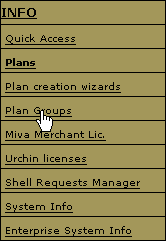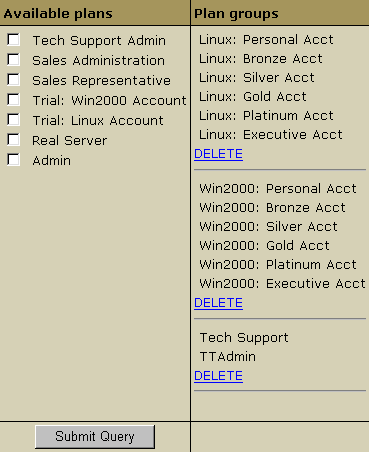|
Understanding Plan Groups
Users can change between plans
only within the same group.
If plans in the group are different by nature (Unix and Windows),
such changes cause losses in user data. To minimize
such losses, plans of different nature are either put
into different groups or left outside any group.
Each plan
can be only in one group. Each group should consist of two
and more plans. It makes
little sense to put one plan to a separate group.
You should always group plans based on their compatibility.
You must always stick to the following rules:
- Don't group plans with different platforms (for example Windows
and Linux hosting), or this will lead to unexpected results.
A very common mistake is to put trial plans, Unix and Windows,
into a separate group. This will not allow trial users
to switch to pay plans, as they are in a different group,
and if users switch from Windows Trial to Unix trial,
they will lose the settings that are unavailable under Unix
plan, including ASP and ODBC service.
- Don't group E-mail Only plans with other plan types.
Users can't switch from E-mail Only to, say, Unix plans, and if
they attempt to do so, they will get an error. Instead, users
need to create a new Unix account and delete the e-mail only account.
- Don't group Reseller plans with any other plan types.
Users can't switch from, say, Unix plan to Reseller plan. Instead, users
need to create a new Reseller account and delete the Unix account.
- Don't group plans if they are bound to different servers.
Compatible plans keep data on the same box and don't require
any reconfiguration.
Starting from version 2.3 users can switch between paid and
no billing plans.
Grouping Plans
To group plans:
- Select Plan Groups in the Info menu:

- You will be presented with a screen with unassigned plans
on the left and groups of compatible plans on the right:

- Check the plans you would like to put into one group and click
Submit Query. The plans will be moved from the list
of Available plans into the Plan groups list.
To ungroup plans in a group, click the DELETE button
next to the group you want to delete.
To add a plan to the group, delete the group first and then
create a new one, with the plan you wanted to add.
To regroup plans, you must ungroup them first, and then group
them the way you want.
| If recurrent fee
calculated based on target plan prices and free units
is: |
| charged | refunded |
| the difference. |
Example 1:
A customer is using 3 dedicated IPs one of which is over free
in his plan and each billing period he pays $2 of recurrent fee for it.
In the middle of one month billing period the user swithches to a plan that
charges $4 of recurrent fee for each IP over 1 free.
On a new plan the user appears to be using 2 dedicated IPs that he must pay
for. The recurrent fee of
$4 (= 2 IPs over free x $4 x 15 days / 30 days) to be paid for the rest of the
billing period is subtracted from the refund of $0.5 (= $2 x 15 days x 50% of
refund percentage/
(30 days x 100%)). As the resulting amount is negative, the user is charged
the difference of $3.5 as the recurrent fee. |
Example 2:
One-month billing period starts and a
user with 3 dedicated IPs on a plan allowing only 2 for free is charged $4
recurrent fee for the 3rd one. Refund percentage for dedicated IP is 100%.
A plan that the user swithces to allows 1 free dedicated IP and
charges $1 as recurrent fee for each one over free. Thus on a new plan the
user
appears to be using 2 dedicated IPs that he must pay for. The recurrent fee of
$1 (= 2 IPs over free x $1 x 15 days / 30 days) to be paid for the rest of the
billing period is subtracted from the refund of $2 (= $4 x 15 days x 100% /
(30 days x 100%)). As the resulting amount is positive, the user is credited
the difference of $1 as a refund.
|
Billing on Reseller Account's Plan Change (version 2.4 and higher)
For example,
Reseller prepays $8 for maintenance of his end user domain.
On the 15th day of 1 month billing period
he switches to a plan providing it for free.
The reseller isn't automatically issued any refunds for this recurrent fee.
For example,
On the 15th day of 1 month billing period
reseller switches from a plan providing free maintenance of end user domains
to a plan providing no free maintenance of end user domains.
Reseller isn't charged recurrent fees for maintenance of existing end user domains
until a new billing period opens for reseller's end user account.
|